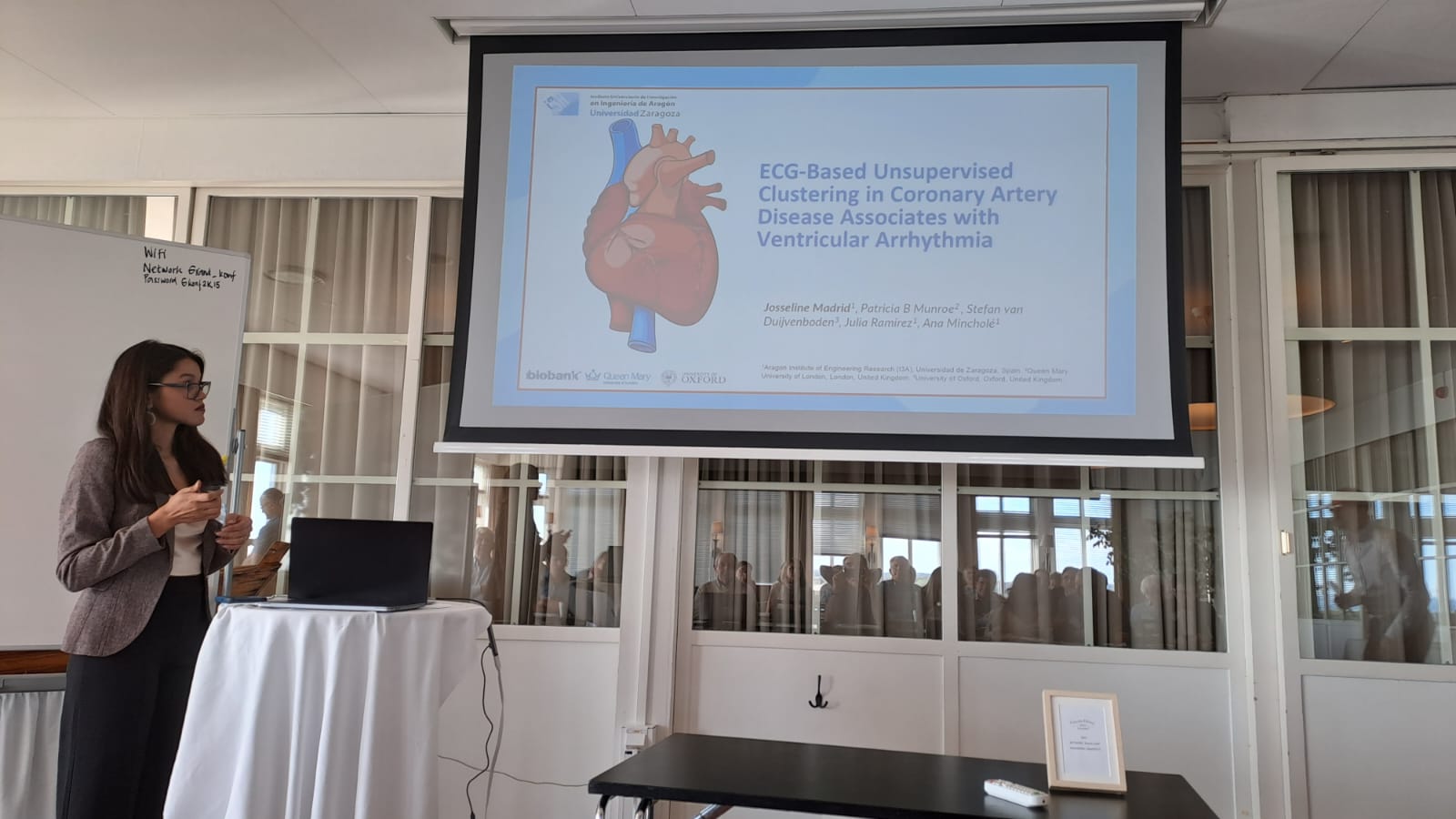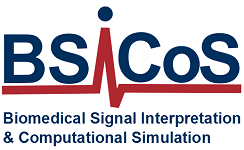20 September, 2023
Four of our young researchers have presented their lines of work



Alba Martín
Bivariate phase-rectified signal averaged QR-RR relationship in the MUSIC database, SR and AF The aim of this study is to investigate the relationship between the RR and QT series through the bivariate phase-rectified signal averaging (BPRSA), assuming that spontaneous changes of RR (trigger signal) cause a response in QT (target signal). Moreover, the prognostic value of new deceleration-related indices in a chronic heart failure (CHF) population will be assessed.
The 24-hour QT and RR series were extracted from 650 Holter recordings acquired in a CHF population. The PRSA and BPRSA techniques were applied to assess the QT/RR dependency. The original PRSA technique is designed for detecting and quantifying recurrent components in biological series, characterized by non-stationarities and noise. First, deceleration anchor points were identified as an RR increase, and segments of 2L+1=15 samples around them were extracted from both the trigger (RR) and the target signal (QT). Finally, all segments were aligned with respect to the anchor and averaged, and four new indices were defined as differences between consecutive samples of the BPRSA series. For comparison, deceleration capacity (DC) and its bivariate analogous (BDC) were also assessed. Prognostic value of deceleration-based computed indices in predicting cardiac death was determined with univariate Cox proportional hazards analysis.
Patients suffering from pump failure death (PFD) had significant lower DC and QT increase after heart rate deceleration. As shown in Table 1, the proposed BPRSA indices were associated to pump failure mortality in the studied population.
Neurys Gómez
Robust Tp/Tpe measurement in a porcine ischemia model In this work, we use a time-warping-based morphology variation index, dw, computed between the peak and the end of the T-wave, and assess its association with the occurrence of ventricular fibrillation (VF) episodes in ischemic conditions. ECG recordings from 26 pigs undergoing a 40-minute coronary occlusion were analyzed. The dw series was obtained by quantifying the morphological differences between the final part of the T wave at different stages of the occlusion and a reference T wave in the control recording. During control recordings, dw remained stationary with a median value along each recording of 1.76 ms, IQR of 1.80, while during artery occlusion followed a well-marked gradual increasing trend as ischemia progressed, with median of 15.47 ms, IQR of 18.53. At the 20-to-25 min period from occlusion onset (and during 5 min prior to VF episode) dw averages in the VF group was significantly higher than in the non-VF group with median values of 40.0 (and 34.4) vs 7.8 (and 7.7) ms, with p-values of 0.002 (and 0.001), respectively. In conclusion, dynamic increases of the dw index during ischaemia progression in pigs are associated with VF occurrence.
Josseline Madrid
ECG-Based Unsupervised Clustering in Coronary Artery Disease Associates with Ventricular Arrhythmia Coronary Artery Disease (CAD) is one of the leading causes of life-threatening ventricular arrhythmias (LTVAs) leading to sudden cardiac death. The presence of CAD slows ventricular conduction heterogeneously across individuals, manifesting as different ECG morphologies. This study
aimed to identify distinct clusters of CAD individuals based on the ECG waves morphology using unsupervised learning, and, investigate their association with LTVA risk.
An average heartbeat was derived from 10-second ECGs (lead I) from 1,444 individuals diagnosed with CAD in the UK Biobank study. The QRS complex and T wave morphology were mathematically quantified by a combination of Hermite functions, the T-wave morphological variations (TMV) index, and standard ECG indices. An unsupervised clustering algorithm based on 2-nearest neighbours was used to classify each individual into 2 distinct clusters. LTVA risk was defined as LTVA mortality or admission to hospital with a LTVA diagnosis 6-months before or after the CAD diagnosis. Statistical nonparametric tests (chi-square test) were performed to evaluate the association of each of the clusters with LTVA risk.
There were a total of 65 LTVA events in the population. The unsupervised algorithm was able to distinguish 2 morphologically distinct clusters in CAD, which significantly differed in terms of LTVA events rate. Cluster 2, which included the highest rate of LTVA events (8%), was characterized by prolonged QTc and Tpec intervals, longer QRS duration, higher TMV indices, lower T amplitude and more evident ST segment deviation than cluster 1.
Using 10-second ECGs from lead I, we have identified in an unsupervised manner a cluster of individuals with CAD at risk of LTVA. Individuals in Cluster 2 present abnormalities in the ECG associated with slowed ventricular conduction and increased dispersion of repolarization that are not explained by age, gender or differences in other risk factors. Future algorithms flagging similarities to the identified morphology of risk could be embedded in wearable devices to detect LTVA risk and initiate prevention measures.
Jimena Rodríguez
ECG-based characterization of the extent, severity and spatial location of acute ischemia in patients with and without prior myocardial infarction Ischemic heart disease is the leading cause of death in the world. Its diagnosis involves monitoring of the dynamic changes in the ST segment of the ECG, although changes in other intervals and waves of the ECG have been observed. One important aspect that is usually not considered is the presence of a prior myocardial infarction (prior MI) and how this affects the response to an ischemic event. Our aim was to quantify the changes in the ECG during acute myocardial ischemia and the effects a prior MI has on them. 12-lead ECG recordings acquired during and prior the acute ischemia induced by percutaneous coronary intervention (PCI) in one of the three main coronary arteries were analyzed. Averaged heartbeats were computed and ECG depolarization and repolarization features were extracted.
Our results show that, in addition to ST deviation, there is a temporal evolution in other ECG parameters during artery occlusion. Repolarization parameters show a faster and stronger change than depolarization ones. The relationship between the extent and severity of the ischemia and the ECG changes was more pronounced in patients with prior MI. A spatial lead profile was described as a function of the occluded artery and the presence of a prior MI. In conclusion, the presence of a prior MI affects the myocardial response to acute ischemia, resulting in more pronounced changes and a stronger relationship with the extension and severity of the ischemia.

